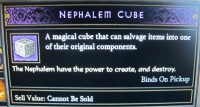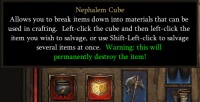
|
Archived Article [e] Nephalem Cube is an archived article about material previously included in Diablo 3. However, it has currently been removed or the article contains outdated facts. The information is stored in Diablo Wiki for posterity. Please note: Links in this article lead to both updated and archived material. This article was last up to date:
|
Details about the Nephalem Cube prior to its removal have been saved for posterity.
The Nephalem Cube is no longer in Diablo III. It was removed in a major game system overhaul announced in January 2012, during the Diablo III Beta test.[1]
When present, the cube was an interface object used for salvaging items into materials. It was introduced along with the Artisans in late 2010, and while changing shape several times during development, it retained the same function until it was removed, along with the Cauldron of Jordan and Stone of Recall in an overhaul of the game interface and crafting/salvaging functions.
The salvaging function of the Nephalem Cube was transferred to Haedrig the Blacksmith, as the option to salvage materials in the dungeon was removed from the game. Such salvaging in the field became less essential with the removal of "white" items from salvaging; when picking up just blue (magical) or better items, the inventory doesn't fill up nearly as quickly. This also necessitated a major overhaul of crafting recipes, as the white quality materials were removed from the game and the quantity of blue materials dropped as well.
Official Removal AnnouncementEdit
Jay Wilson revealed the demise of the Nephalem Cube in a blog post in January 2012.[1]
Nephalem Cube Story ImplicationsEdit

While the cube has been removed from the game, speculation that it might tell us something about the story and plot of Diablo III continues.
The "Nephalem" were the first humans in Sanctuary. They came into being as the offspring of the mating between Inarius (an Angel) and Lilith (a demon), and according to the world lore, these early Nephalem had the potential to be stronger than angels or demons. The creation of the Worldstone, a relic that largely kept the forces of the Burning Hells from entering into Sanctuary, somehow also served to sap the natural powers of the Nephalem.
Much of the speculation about Diablo III's plot involves the destruction of the Worldstone by Tyrael twenty years before the time of Diablo III, and the changes that humans might be undergoing, as they regain some of their long lost Nephalem might.
Thus the fact that the salvage box is called the Nephalem Cube has (at least) two possible implications.
- The name might simply be a reference to the ancient days and the cube's original origin (created by the Nephalem ages ago).
- Or the box might have some connection to ongoing/upcoming events, as the Nephalem are reborn in modern man.
It's not clear how much fans would have even considered the second possibility, had not Bashiok pointed it out and termed it a spoiler. After all, the cube in Diablo II was named the Horadric Cube, but it didn't herald any return or relevance of the ancient Horadric order in the game. It merely referred to the cube's ancient origin. Fans would likely have assumed the same of the Nephalem Cube, had not Diablo III's community manager suggested otherwise.
There is a three level dungeon in Act One (not found in the Beta test) called the Nephalem Caves; many fans speculated that perhaps the full game would send players on a quest to that dungeon, and that's where we would find the Nephalem Cube, along with additional story information about the Nephalem. Now that the cube is gone, it's not known if that dungeon will keep the same name and/or plot advancing function.
RPG ParallelsEdit
Salvaging is similar to World of Warcraft's' Disenchanting, a Sub-skill of Enchanting.
It's also virtually identical to the Hellgate: London system that allowed players to break down items into their components, which could then be used in recipes to create new items.
Nephalem Cube tooltip as seen during the beta test.


